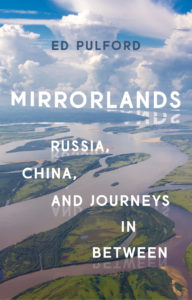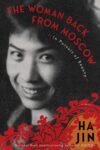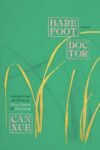I knew I would like Ed Pulford when I read in the preface of his book Mirrorlands: Russia, China, and the Journeys in Between that his first guide to Russia was “the protagonist of a novel I read as a seventeen-year-old, an errant chauvinist . . . who must have appealed to my teenage male megalomania.” And when in the first paragraph of the travelogue proper he describes Istanbul as Moscow’s “Eurasian twin” and “Second Rome” I knew we would be fast friends. I have reservations about any text on the geopolitics of Russia that doesn’t reference Turkey as a secret sharer. While the similarities between the westernization of the two countries are quite well-known, Pulford’s book draws our (my) attention to the other tie that binds Turkey and Russia: the various Turkic peoples that live in the latter, particularly in the regions bordering China.
Mirrorlands is the story of Pulford’s journey, on buses and trains, from Moscow all the way to Beijing as he tries to understand the cultural exchanges and confrontations between two of Asia’s sprawling countries. The mirrorlands he refers to are not so much the countries themselves but the borderlands he travels through, beautifully reflected in the image of the Amur on the front cover of the book. While Mirrorlands may be a book about how Russia and China mirror one another, I have done a rogue reading of it, focusing on what it says about how Russia mirrors Turkey at the same time. I have a hunch that Pulford will approve of this reading, as on page 5 he declares: “Russia’s love-hate interactions with Turkey over the centuries have been critical to its relations with ‘Eastern’ or ‘Asian’ places more broadly.”
This, the fact that I too see Turkey and Russia as reflecting each other’s fallacies, is the primary reason I picked up Mirrorlands from the shelf. China was naturally a bonus, for aren’t we told over and over again that they are our imminent overlords? I would say I was ready for the changing of the guard from the US to China, but then, the Chinese don’t seem to like Muslims much. Worse, they don’t like Muslims particularly when they are Turkic. Maybe, then, the reason I was drawn to the book was a need for confirmation that the Slavic hordes would be a bulwark against the Chinese threat. Pulford does not put it as crudely as I do but the underlying question is: who would win in a fight? The more sophisticated form this question takes in the book is “Which country has benefited more from socialism and has been able to adapt to the new global economy?” and the rather obvious answer is China. My own concerns are also addressed towards the end, when Pulford compares how the two countries’ minorities fare. Russia, through lack of proper administration rather than benevolence it seems, is the better place to be a minority.
Starting his journey from Moscow with the premise of “mirrorlands” in mind, Pulford starts seeing the city anew, picking up conversations in Uzbek, Azeri, and Tajik, now “more conscious of the city’s Asianness.” I myself was alerted to the “Asianness” of Russia about a decade ago when I attended Russian classes in Istanbul. It may not be a universally known fact that Turks are very interested in Russian literature and cinema. I have not conducted a poll but an ordinary Turk is more likely to have read a Russian classic — Tolstoy and Dostoyevsky are favourites — than, say, French or English. The moodiness suits us and we find fellow sufferers in Russian attempts at Frenchifying themselves. Imagine my surprise, then, when our Tatar tutor walked into the class, and not some character from War and Peace. But don’t Tatars speak . . . Tatar? Our tutor was not only Tatar but a Tatar whose family had been displaced to Uzbekistan. So just trying to figure out where our teacher was from, I had already learnt quite a bit of Russian history and how the peoples of the country had been dispersed through war and forced migration — not unlike Turkey. A bit of reading further revealed that Tatars had ruled over of Moscow, and that Arbat came from the word arabat, a Turkic compound for horse car. Pulford says the word comes from an Arabic word meaning suburb, and others claim it comes from “gorbat,” for “bumpy” (I am of course sticking to the Turkic).
In Pulford’s story Tatars and Uzbeks pop up throughout, all the way to Harbin. Before he moves eastward, to bear witness to the several physical and cultural displacements between the mirrorlands of his title, we linger a little longer in Moscow, to digest fully the cultural entanglements of the capital his journeyings will begin from. He speaks of a Turkish entrepreneur’s attempts to go to a night club to prove his Kemalist credentials — alert as he is to the culture wars that have happened not just in Russia but also in neighboring lands. Having left the nightclubbing Turk in Moscow, he sets off to interact with the Turkic peoples of Yakutia. It seems quite fateful that both to the West and to the East, Turkic peoples occupy the borderlands of the Russian Empire — and the presence of these peoples determine how porous these borders can be.
Pulford is by all counts a superb linguist. He makes small talk with Chinese salesmen in Russia — it is very clear who the better traders are — and has conversations with people in Russian enclaves in Chinese territories. One aspect of Pulford’s narrative that endeared it to me is the way he translates these Chinese and Russian conversations. He doesn’t make the locals sound like half-wits through literal translations (as you will find in many a travelogue) but renders them into very colloquial English, so you take what these people are saying very seriously. He also dabbles in phrenology, trying to decipher “Russian” and “Asian” faces. It’s a crime many of us commit. Just the other day I saw the news of a political activist in Russia who killed himself, protesting the dying of his language. He looked just like my paternal grandfather and so I googled to learn about Durmutia, yet another nation in the interstices of Slavic and Turkic ethnicities.
One of Pulford’s aims in this book seems to be inspecting the railways and trains that cross and/or run parallel to the Russia-China border. As those in the know will know, there is hardly anything more essential to have on your CV as a British man of letters than having ridden on the Transsiberian, which Pulford duly does. To take the train to Tynda he spends a day in Neryungri (both on the Russian side of the border) and at the hotel reception his own physiognomy elicits the question whether he’s from the Baltic. I chuckle at this, Baltic being a short hand for Western Europe, as it was in the Soviet 80s series Sherlock Kholmz. One of the reasons given for the fascination with the Transsiberian is the frisson of riding a train so close to China. But surely, one can actually just take a plane to Beijing? Ah, but what do I know about the romance of train travel? Pulford tells us the story of how just like the borderlands, the railways seem to have changed hands many times; from the time of their inception, to the WWII and beyond. He makes the interesting observation of how expanding work on the Transsiberian saw the collapse of Tsarist Russia, just as BAM railway saw the end of the USSR. This naturally puts me in mind of the Baghdad Railway, destroyed by T. E. Lawrence and his Bedouin, spelling the end of the Ottoman Empire.
Pulford explains the mystique of train travel through the “intimate communities that form on board,” a sort of focus group you can count on to give you the lay of the land you’re traversing. A more varied version of Thomas Friedman’s taxi driver for the anthropologist, I guess. These train rides do enable us to see individuals and families of the different peoples of Russia, and appreciate the state’s mechanism of dispersing its various peoples throughout a vast geography, so a single Russian citizen will have loyalties to different parts of the country at once: reminding of the great civil servant migrations in Turkey. When it comes to the more dispossessed peoples in the east of the county, Pulford speaks of the “intercommunity familiarity engendered by colonialism,” a dangerously revisionist approach, but one that sounds plausible.
On these trains Pulford also communes with the ghosts of earlier travellers. Among others there is Qu Quibai, a Chinese intellectual and Mao Zedong’s classmate from Peking University’s Marxist seminars, en route to Moscow, to see how comrades are faring in 1920. There is also Ethel Brilliana Alec-Tweedie, reacting to things as you would imagine someone with such a name would. She assures the reader that Russians are Asiatics, and terribly hirsute to boot. Which leads us on to the interesting panorama of masculinities that the book offers. Russian men don’t come out of it too well — in the borderlands, Russian women are keen to marry Chinese men because they are much more hard working; this accounts for the large numbers of Russian women ending up with Turkish men too. Further to the East, in Khabarovsk, we meet a Russian young man whom Pulford introduces to us in the following terms, “like many educated young Russians, Ilya didn’t drink,” pointing to the country’s age-old problem which probably counts for the fact that Russian men have one of the shortest life expectancies in the developed — and naturally I used the word with reservation — world. In such circumstances Russian men’s alleged Europeanness counts for little, although in the Russian imagination only Russian men can be counted on to bring civility to the East; as in the very popular 70s Soviet film White Sun of the Desert. The masculinity that observes both, the British one, is non-committal here, alert to male bodies jostling against one another on trains and crowded corridors, horrified that at one point a taxi-driver offers to find him a Korean prostitute. Pulford’s persona in this book, like all other Englishmen interested in Russia, is Anthony Burgess manqué.
One disturbing mirroring with Turkey is when Pulford speaks about how Russian construction sites seem to be in a standstill compared to the swift rise of blocks on the Chinese side of the Amur River. The uncompleted bridge between Tongjiang and Nizheneleninskoe turns into a metaphor, as the Chinese have finished their part of the structure whereas the Russians are yet to start work in earnest. Elsewhere he describes “concrete shells” on the Russian side that make one question whether they are building sites or ruins — a sense I often get when I try to get out of Istanbul in a car with concrete walls on either side of the highway.
Still, Russia holds an old-world European charm for the Chinese, and maybe the more derelict the land of “intermarried loyals, epauletted counts, dukes and barons” is in these borderlands, the better it is for tourism. It is because of the sheer numbers and purchasing power of Chinese tourists that Pulford comes across more museumized versions of “Russian culture” than Chinese. He says “each side seemed to prefer a simulacrum of the other over direct contact,” a dictum that would hold true for all international/neighbourly relations. He praises Napoleon cakes and Alenka chocolate — the only better Russian foodstuff compared to the Chinese. Just as Europe becomes a chimera in its reproductions in the East — doesn’t the Russianest of cakes have a French name? — the word Orient(al) is bandied about in Russia, as in Museum of the Orient in Moscow, whose artefacts include Buryat, Nanai and Chechen rugs, Kazakh hats and Georgian paintings, Persian and Pashtun costumes, Chinese Zhou-dynasty pottery, and an ivory eagle from the Japanese Emperor Meiji. As Pulford reminds us elsewhere in the book, exoticisation at the imperial centre can very quickly turn to demonization.
The Nanai — apparently referred to by the Russians not so endearingly as “Fishskin Tatars” — are yet another historical entity that turn into metaphor in Pulford’s text. This people divided by a border, and with very strong connections to the Amur river that runs between the two countries, have another name on the other side of the mirror: “Hezhe.” In this beautiful wetland landscape, the Muslims get a walk-in role tilling the land, like one of those miasmic apparitions found in Tarkovsky’s films. But we are quickly back with the Nanai/Hezhe. In Khabarovsk, Pulford gets to observe a “performance” by the Nanai and chats to Leonid, an activist who wants more rights for the dispersed and divided people. As elsewhere in the world, rights for multicultural citizens seem to be a zero-sum game, and Leonid asks: “You want to know what it feels like to be Nanai? Just wait until you’re swamped by Chinese and Central Asian guest workers” One of his Hezhe brethren in turn offers an insight as to the difference between the two countries: “Basically, there are lots of mafia in Russia, whereas in China we only have one mafia. It’s called the Communist Party.” The Nanai international claim to fame is that one of their villages is the birthplace of Kim Jong Il: alongside the Russian, Chinese and Turkic peoples, Koreans’ history is also entangled in these borders. And people have longer memories than you think. On the Chinese side Pulford gets a pat on the shoulder because the Brits had fought against the Manchu Qing Dynasty, but also is twice chid as people tell him they haven’t forgotten the Opium Wars.
Just as I start thinking that we have strayed way too East for Istanbul to be resonant, Pulford tells us that the Golden Horn Bay in Vladivostok is referred to as the “Eastern Bosphorus.” This is where, Pulford tells us, he studied Chinese at the “Oriental Institute” — the Orient, here, denoting the non-Russian cultures in the region, what “we” in Europe might call “Far East.” Anything and everything seems to be in the remit of the word Orient. I should know, having studied at an Oriental Institute for my Ottoman literature course, rubbing shoulders with Tibetan Studies people. The word Asia is just as imprecise: I have witnessed “Asian Restaurant” signs offering Indian food in Japan.
The minute I think Pulford has omitted something from a description, he obliges me in the next paragraph. For instance, he gives an inventory of the various faiths in Harbin, including Orthodox Christians and Jews (Ehud Olmert was born there, apparently — also, he describes the synagogue as in the “style of a Saracen’s palace”) and right after I scribble in the margins: “What about Muslims?,” he goes on to describe an early 20th century Tatar Mosque. The Uyghurs remain absent from his narrative, although there’s a passing acknowledgement that he studied in Urumqi at one point. Where the text fails to address China’s treatment of its Muslims — one might argue this would be beyond the ambitions of this book — Pulford seems, almost as a by-product, to answer the persistent political question of whether Islam belongs in Europe. He describes Chinese newlyweds who have a habit of posing in front of European looking buildings: “That a former mosque now hosts Chinese couples mimicking the sartorial stylings of Western Christian weddings seems to encapsulate the extraordinary patchwork multiplicity of Harbin’s history” he says. The Constantinopolitan spectre also raises its head again when he speaks of the orthodox church St. Sophia.
In 2014 when Pulford made his journey, China had not yet gone full concentration camp level of destruction of the Uyghur Muslims, but he alerts us shortly to the methods that the state uses, historicizing the application of draconian measures:
The Orwellian measures that the Communist Party now deploys in Xinjiang and Tibet demonstrate the difficulty of ruling from such geographical and cultural distance, but in this the Chinese capital’s experience is far from unique. Moscow too remains isolated from the eastern and southern domains where it historically first met China . . . From the vast haemorrhaging of the former tsarist territories during the Soviet collapse to ongoing friction in the mountainous north Caucasus, the capital Russians call simply their “centre” is also trying to consolidate past conquests.
To me, this is where China and Russia mirror, or rather prove a test case for one another, most; the policies that define the very reflective, marshy territory that separates the two kingdoms. The Chinese mirror image works very well, but of course my mind wanders back to my original interest in the book, in Russia and Turkey, and how the Ottoman Empire knows a thing or two about haemorrhage, including a change of the capital city.
And so we move on to Beijing, which, it turns out, was once a Mongolian settlement called Khanbaliq, just like Moscow had been an Tatar town. In Beijing, Pulford seems to repeat his earlier experience in Moscow, as he hears “a din of shouted Chinese, Slavic and Turkic languages.” He continues: “An Uyghur melon vendor was having an altercation with an Uzbek woman over slices of cantaloupe. Uzbek and Uygur, closely related central Asian languages, are Russified and Sinicised siblings, and are largely mutually intelligible” and largely unintelligible to the Turk that still bares the patronymic, living thousands of kilometres west, having mixed with Mediterranean peoples. Thus, to the very end, Pulford delivers good on the claim at the beginning of his book, that Turkey proves the other through which Russia positions itself vis-à-vis Europe and the East. The delight of this book, for me, is to find out that a Turkic spectre helps shape Russian interaction with China as well.
This post may contain affiliate links.








